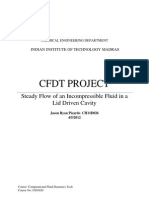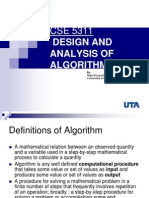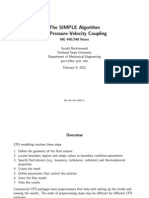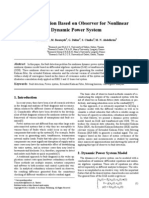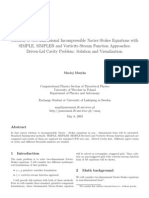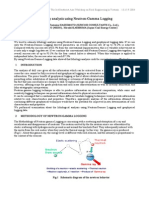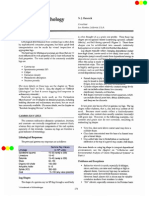Computational Fluid Dynamics (CFD)
Computational Fluid Dynamics (CFD)
Uploaded by
Suta VijayaCopyright:
Available Formats
Computational Fluid Dynamics (CFD)
Computational Fluid Dynamics (CFD)
Uploaded by
Suta VijayaOriginal Description:
Original Title
Copyright
Available Formats
Share this document
Did you find this document useful?
Is this content inappropriate?
Copyright:
Available Formats
Computational Fluid Dynamics (CFD)
Computational Fluid Dynamics (CFD)
Uploaded by
Suta VijayaCopyright:
Available Formats
Computational Fluid Dynamics (CFD)
Navier-Stokes Equations
Reynolds Number
Numerical Analysis of Navier-Stokes Equations
SIMPLE and PISO algorithm
OpenFoam Project
Some results for the Lid-driven cavity flow
http://www.phy.syr.edu/courses/PHY600.10Fall/Presentations/jorge.pdf
Navier Stokes Equations
For an Incompressible Newtonian Fluid
( ) 0 = V +
c
c
u
t
Forces
Viscous
Forces
essure
Dt
u D
u p u u
t
u
2
Pr
V + V =
|
.
|
\
|
V +
c
c
Continuity Equation
viscosity : pressure, : velocity, : density, : p u
In order to make some estimates, let us suppose we have a typical change in
speed given by U over a typical length L.
Forces Inertial
2
~
L
U
Forces Viscous
2
~
L
U
Viscosity Kinematic : Number, Reynolds : Re
/ Forces Viscous
Forces Inertial
u
u
= = ~
LU LU
For low Reynolds number we have Stokes (or creeping) flow. This is the typical regime
where cells move.
Reynolds Number
Numerical Analysis of Navier Stokes Equations
The first issue is to select the points in the domain at which the values of the
unknown dependent variables are to be computed.
Collocated Arrangement Staggered Arrangement
Issues solving Navier-Stokes Equations
Lack of an independent equation for the pressure.
Presence of non-linear quantities in the convective
term.
The equations are intricately coupled.
Discretisation Process
Time derivative: It is used the explicit Euler method unless
detailed time history of the flow be required.
( ) ( ) ( )
t
u u
t
u
n n
A
~
c
c
+
1
Gradient, Divergence and Laplacian: The discretisation typically is
performed using Gauss theorem according to the following equations
Gradient
f
f
f
s V
S S d dV | | |
} }
= = V
Divergence
} }
= = V
f
f
S V
u S u S d dV u
( ) ( ) ( ) Laplacian
f f
f
f
S V
S S d dV | | | V I = V I = V I V
} }
Algorithm: SIMPLE
( ) ( ) ( )
J i J I J I nb nb J i J i
A p p u a u a
x
p
y
u
y x
u
x
vu
y
uu
x
, , , 1 , ,
+ =
c
c
|
|
.
|
\
|
c
c
c
c
+ |
.
|
\
|
c
c
c
c
=
c
c
+
c
c
( ) ( ) ( )
j I J I J I nb nb j I j I
A p p v a v a
y
p
y
v
y x
v
x
vv
y
uv
x
, , 1 , , ,
+ =
c
c
|
|
.
|
\
|
c
c
c
c
+ |
.
|
\
|
c
c
c
c
=
c
c
+
c
c
( ) ( ) ( ) ( ) | | ( ) ( ) | | 0 0
, 1 , , , 1
= + =
c
c
+
c
c
+ + j I j I J i J i
vA vA uA uA v
y
u
x
The algorithm is essentially a guess-and-correct procedure for the calculation
of pressure on the staggered grid.
From a guessed we get velocities
*
p
( ) ( )
( ) ( ) 2
1
,
,
*
1 ,
* *
,
*
,
,
,
*
, 1
* *
,
*
,
j I
J I J I nb
nb
j I
j I
J i
J I J I nb
nb
J i
J i
A p p v a v a
A p p u a u a
+ =
+ =
We define the correction pressure p as the difference between the correct pressure
and the guessed pressure. Analogously for the velocities.
' ' '
* * *
v v v u u u p p p + = + = + =
By subtracting Eqs. (1) and (2) we get
( ) ( )
( )
j I J I J I nb nb j I j I
J i J I J I nb nb J i J i
A p p v a v a
A p p u a u a
, , 1 , , ,
, , , 1 , ,
' ' ' '
3 ' ' ' '
+ =
+ =
0 ' , ' : point Key ~
nb nb nb nb
v a u a
The pressure correction equation is susceptible to divergence
Unless some under-relaxation is used. We then have
1 0 , '
*
s s + =
p p
new
p p p o o
We need some not too small to have appropriate
Computation speed and not too big to assure convergence.
Unfortunately, the optimum value are flow dependent and
must be sough on a case-by-case basis.
p
o
From (3) we get u and v in terms of p
We use continuity Eq. to provide a relation for p
1 , 1 , 1 , 1 , , 1 , 1 , 1 , 1 , ,
' ' ' ' '
+ + + +
+ + + =
J I J I J I J I J I J I J I J I J I J I
p a p a p a p a p a
The PISO algorithm
PISO involves one predictor step and two corrector steps and
may be seen as an extension of SIMPLE, with a further
corrector step to enhance it.
PISO was developed originally for the non-interative
computation of unsteady compresible flows, but it has been
adapted succesfully on steady state problems.
Although the method implies a considerable increase in
Computational effort it has been found to be efficient and fast.
OpenFoam Project
OpenFoam is first and foremost a C++ library for the customisation
and extension of numerical solvers for continuum mechanics
problems, including computational fluid dynamics (CFD).
Apart from the standard solvers, one of the distinguishing features of OpenFOAMis
its relative ease in creating custom solver applications. OpenFOAMallows the user to
use syntax that closely resemble the partial differential equations being solved. For
example the equation
( )
( ) p u u
t
u
V = V V V +
c
c
is represented by the code
Next I used the program to study the Lid-driven cavity flow. This is a typical phenomena
to test CFD algorithms.
Pressure
Velocity flow field
You might also like
- Decision Analysis ForPetroleum Exploration - Thomas W. EnglerDocument18 pagesDecision Analysis ForPetroleum Exploration - Thomas W. EnglerSuta Vijaya100% (1)
- Decision Analysis ForPetroleum Exploration - Thomas W. EnglerDocument18 pagesDecision Analysis ForPetroleum Exploration - Thomas W. EnglerSuta Vijaya100% (1)
- Tension Test: Lab Report 1 1Document9 pagesTension Test: Lab Report 1 1Санжар ЖумаханNo ratings yet
- Lid Driven Cavity - SIMPLEDocument24 pagesLid Driven Cavity - SIMPLEJason Ryan Picardo100% (10)
- Characteristic Logging Tool Responses For Various LithologiesDocument1 pageCharacteristic Logging Tool Responses For Various LithologiesSuta VijayaNo ratings yet
- New Techniques For Using Old Geophysical Logs in Reservoir CharacterizationDocument25 pagesNew Techniques For Using Old Geophysical Logs in Reservoir CharacterizationSuta VijayaNo ratings yet
- Computational Fluid Dynamics: Course NotesDocument68 pagesComputational Fluid Dynamics: Course NotesPankaj GuptaNo ratings yet
- CFD NotesDocument68 pagesCFD NotesPraveen P JoseNo ratings yet
- 1 Linear Systems, Superposition, and Convolution: Function and The Unit Step Function. The Unit Step Is Defined AsDocument3 pages1 Linear Systems, Superposition, and Convolution: Function and The Unit Step Function. The Unit Step Is Defined AsCris JacksonNo ratings yet
- Ch-06: Methods For Unsteady ProblemsDocument29 pagesCh-06: Methods For Unsteady ProblemsAttique JavaidNo ratings yet
- P P P Piiii W W W W: Numerical Methods For Elliptic EquationsDocument52 pagesP P P Piiii W W W W: Numerical Methods For Elliptic EquationsImran Sajid ShahidNo ratings yet
- 1.3 Algorithms and ConvergenceDocument13 pages1.3 Algorithms and Convergenceسعود يحيىNo ratings yet
- 19 MacCormack TechniqueDocument14 pages19 MacCormack TechniquekkkrajaNo ratings yet
- SSRN Id3671441Document9 pagesSSRN Id3671441Abhiroop VaddiparthiNo ratings yet
- Other - Comparison of Pressure-Velocity Coupling Schemes For 2D Flow (Audi)Document4 pagesOther - Comparison of Pressure-Velocity Coupling Schemes For 2D Flow (Audi)me_dejoelcamion1946No ratings yet
- The SIMPLE Algorithm For Pressure-Velocity Coupling: ME 448/548 NotesDocument26 pagesThe SIMPLE Algorithm For Pressure-Velocity Coupling: ME 448/548 NotesDuílio Ferronatto LeiteNo ratings yet
- CO2038 Lab5 CCO1 2252116Document24 pagesCO2038 Lab5 CCO1 225211627-Lục Tấn Phúc-11A8No ratings yet
- 08 EE394J 2 Spring12 LoadflowDocument15 pages08 EE394J 2 Spring12 LoadflowkgskgmNo ratings yet
- PID Controller Design For Multiple Time Delays System: Asma Karoui, Rihem Farkh, Moufida KsouriDocument7 pagesPID Controller Design For Multiple Time Delays System: Asma Karoui, Rihem Farkh, Moufida KsouriNagulapati KiranNo ratings yet
- 1.3 Fluid Flow EquationsDocument26 pages1.3 Fluid Flow EquationsJordi VilaNo ratings yet
- Chap 8Document50 pagesChap 8Karthick ManojNo ratings yet
- IN 227 Control Systems Design: Lectures 7 and 8Document15 pagesIN 227 Control Systems Design: Lectures 7 and 8AbhinavNo ratings yet
- Design and Implementation of Proportional Integral Observer Based Linear Model Predictive ControllerDocument8 pagesDesign and Implementation of Proportional Integral Observer Based Linear Model Predictive ControllerIDESNo ratings yet
- NLOPFDocument34 pagesNLOPFKelly SantosNo ratings yet
- Convergence Acceleration of Alternating SeriesDocument10 pagesConvergence Acceleration of Alternating SeriesblablityNo ratings yet
- Assignment - 2Document16 pagesAssignment - 2Shamsi MursalliNo ratings yet
- Technical Note - Autoregressive ModelDocument12 pagesTechnical Note - Autoregressive ModelNumXL ProNo ratings yet
- Gas Dynamics and Jet Propulsion PDFDocument49 pagesGas Dynamics and Jet Propulsion PDFdass143143No ratings yet
- CSE 5311 Design And: Analysis of AlgorithmsDocument19 pagesCSE 5311 Design And: Analysis of Algorithmspv28No ratings yet
- LQRDocument14 pagesLQRStefania Oliveira100% (1)
- Methods To Track Moving Fluid InterfacesDocument9 pagesMethods To Track Moving Fluid Interfacesgego477No ratings yet
- Load Flow Analysis - I: Solution of Load Flow and Related Problems Using Gauss-Seidel Method 5Document7 pagesLoad Flow Analysis - I: Solution of Load Flow and Related Problems Using Gauss-Seidel Method 5samkousNo ratings yet
- ### Note V5 - Frequency Response WTH Bode Plot NEW VERSION 2023Document22 pages### Note V5 - Frequency Response WTH Bode Plot NEW VERSION 2023Okewunmi PaulNo ratings yet
- Correlation and Regression AnalysisDocument23 pagesCorrelation and Regression AnalysisMichael EdwardsNo ratings yet
- Super-Exponential Methods For Blind Deconvolution: Shalvi and Ehud Weinstein, IeeeDocument16 pagesSuper-Exponential Methods For Blind Deconvolution: Shalvi and Ehud Weinstein, IeeeengineeringhighNo ratings yet
- 08 - Transfer Function - Examples - 040424Document21 pages08 - Transfer Function - Examples - 040424haemin1523No ratings yet
- Adaptive Simulation of Turbulent Flow Past A Full Car Model: Niclas Jansson Johan Hoffman Murtazo NazarovDocument7 pagesAdaptive Simulation of Turbulent Flow Past A Full Car Model: Niclas Jansson Johan Hoffman Murtazo NazarovLuiz Fernando T. VargasNo ratings yet
- Introduction To Population PKDocument45 pagesIntroduction To Population PKTran Nhat ThangNo ratings yet
- Reliability Analysis of Welds in Nuclear Power Plant Reactor VesselsDocument39 pagesReliability Analysis of Welds in Nuclear Power Plant Reactor VesselsPratik TagwaleNo ratings yet
- Recursive Parameter Estimation: in This Chapter We Present Very Briefly The Basic Algorithm For Recursive LeastDocument8 pagesRecursive Parameter Estimation: in This Chapter We Present Very Briefly The Basic Algorithm For Recursive Leastrarunr1No ratings yet
- Applied Mathematics and Computation: Kaining Wu, Xiaohua DingDocument8 pagesApplied Mathematics and Computation: Kaining Wu, Xiaohua DingJese MadridNo ratings yet
- Notes On CFDDocument3 pagesNotes On CFDBoyang QinNo ratings yet
- The SIMPLE Algorithm For Pressure-Velocity Coupling: ME 448/548 NotesDocument26 pagesThe SIMPLE Algorithm For Pressure-Velocity Coupling: ME 448/548 Noteskassu303No ratings yet
- Fault Detection Based On Observer For Nonlinear Dynamic Power SystemDocument8 pagesFault Detection Based On Observer For Nonlinear Dynamic Power SystemAbdulazeez Ayomide AdebimpeNo ratings yet
- Lid Driven CavityDocument18 pagesLid Driven Cavityali_naghedifarNo ratings yet
- 2-Diffusivity Equation-Linear PDFDocument30 pages2-Diffusivity Equation-Linear PDFLoh Chun LiangNo ratings yet
- Newton Raphson & JacobiDocument21 pagesNewton Raphson & Jacobimadhes14No ratings yet
- Bifurcation in The Dynamical System With ClearancesDocument6 pagesBifurcation in The Dynamical System With Clearancesklomps_jrNo ratings yet
- Final Exam Solutions: N×N N×P M×NDocument37 pagesFinal Exam Solutions: N×N N×P M×NMorokot AngelaNo ratings yet
- Chemical Reaction Engineering. LevenspielDocument15 pagesChemical Reaction Engineering. LevenspielcespinaNo ratings yet
- Kaka de 09 GeneralizationDocument8 pagesKaka de 09 Generalizationtamann2004No ratings yet
- Robust Linear ParameterDocument6 pagesRobust Linear ParametervinaycltNo ratings yet
- Introduction: PID Controller Design: SystemDocument14 pagesIntroduction: PID Controller Design: SystemRantharu AttanayakeNo ratings yet
- Homework 4Document2 pagesHomework 4dogudoguNo ratings yet
- Adv Math ProjectDocument19 pagesAdv Math ProjectJeanne Kamille Evangelista PiniliNo ratings yet
- (A) Modeling: 2.3 Models For Binary ResponsesDocument6 pages(A) Modeling: 2.3 Models For Binary ResponsesjuntujuntuNo ratings yet
- Student Solutions Manual to Accompany Economic Dynamics in Discrete Time, second editionFrom EverandStudent Solutions Manual to Accompany Economic Dynamics in Discrete Time, second editionRating: 4.5 out of 5 stars4.5/5 (2)
- Level Set Method: Advancing Computer Vision, Exploring the Level Set MethodFrom EverandLevel Set Method: Advancing Computer Vision, Exploring the Level Set MethodNo ratings yet
- Mathematical Analysis 1: theory and solved exercisesFrom EverandMathematical Analysis 1: theory and solved exercisesRating: 5 out of 5 stars5/5 (1)
- Student's Solutions Manual and Supplementary Materials for Econometric Analysis of Cross Section and Panel Data, second editionFrom EverandStudent's Solutions Manual and Supplementary Materials for Econometric Analysis of Cross Section and Panel Data, second editionNo ratings yet
- Standard-Slope Integration: A New Approach to Numerical IntegrationFrom EverandStandard-Slope Integration: A New Approach to Numerical IntegrationNo ratings yet
- Lithology Analysis Using Neutron-Gamma LoggingDocument6 pagesLithology Analysis Using Neutron-Gamma LoggingSuta VijayaNo ratings yet
- KPI - by Duncan WilliamsonDocument6 pagesKPI - by Duncan WilliamsonSuta VijayaNo ratings yet
- Environmental, Social and Governance KPIDocument14 pagesEnvironmental, Social and Governance KPISuta Vijaya100% (1)
- Discovering The Right Key Performance IndicatorsDocument18 pagesDiscovering The Right Key Performance IndicatorsSuta VijayaNo ratings yet
- KPI Deployment GuideDocument36 pagesKPI Deployment Guideser222No ratings yet
- New Approach To Calculate The Mud Invasion in Reservoirs Using Well Logs - Mariléa RibeiroDocument5 pagesNew Approach To Calculate The Mud Invasion in Reservoirs Using Well Logs - Mariléa RibeiroSuta VijayaNo ratings yet
- Valuing Exploration Andproduction ProjectsDocument3 pagesValuing Exploration Andproduction ProjectsSuta VijayaNo ratings yet
- Quick-Look LithologyDocument1 pageQuick-Look LithologySuta VijayaNo ratings yet
- Calculation Procedures - Reserve EstimationDocument8 pagesCalculation Procedures - Reserve EstimationSuta VijayaNo ratings yet
- Uncertainty Quantification and Risk Analysis For Petroleum ExplorationDocument9 pagesUncertainty Quantification and Risk Analysis For Petroleum ExplorationSuta VijayaNo ratings yet
- Investment and Decision Analysis For Petroleum ExplorationDocument24 pagesInvestment and Decision Analysis For Petroleum Explorationsandro0112No ratings yet
- Cake FiltrationDocument85 pagesCake FiltrationSuta Vijaya100% (1)
- Basic Aspects of DiscretizationDocument56 pagesBasic Aspects of DiscretizationSuta VijayaNo ratings yet
- Introduction To CFD Basics Rajesh BhaskaranDocument17 pagesIntroduction To CFD Basics Rajesh BhaskaranSuta VijayaNo ratings yet
- Computational Fluid Dynamics (CFD) - Markus Peer RumpfkeilDocument29 pagesComputational Fluid Dynamics (CFD) - Markus Peer RumpfkeilSuta VijayaNo ratings yet
- ES 11 Lec 07 Rigid Body Friction and Belt Friction PDFDocument14 pagesES 11 Lec 07 Rigid Body Friction and Belt Friction PDFMark Oña100% (1)
- Science9 - Q2 - Mod9 - Percentage Composition of A Compound - v3Document25 pagesScience9 - Q2 - Mod9 - Percentage Composition of A Compound - v3Regina Minguez Sabanal100% (8)
- US Regulations For Flexible Packaging MaterialsDocument10 pagesUS Regulations For Flexible Packaging MaterialsBValidNo ratings yet
- Met O WK 1-4Document29 pagesMet O WK 1-4reoverosjonathan1No ratings yet
- Aquasorb OZ - Antiozonates Softner For Denim Fabrics.Document11 pagesAquasorb OZ - Antiozonates Softner For Denim Fabrics.L.N.CHEMICAL INDUSTRYNo ratings yet
- World Geography MCQsDocument62 pagesWorld Geography MCQsLKNo ratings yet
- 12 U Orgo - 1 - Hydrocarbon Nomenclature WorksheetDocument4 pages12 U Orgo - 1 - Hydrocarbon Nomenclature WorksheetZia Rathore100% (1)
- Mid Term Paper Advanced Spectroscopic Techniques F-2022Document2 pagesMid Term Paper Advanced Spectroscopic Techniques F-2022AnumNo ratings yet
- Basics of Thread Rolling Final LP 23JAN2017Document82 pagesBasics of Thread Rolling Final LP 23JAN2017Daniel felipe Ariza carranzaNo ratings yet
- RSC Advances: PaperDocument6 pagesRSC Advances: Paperuvir iitmNo ratings yet
- Jet Diffusers Single PagesDocument13 pagesJet Diffusers Single PagesFareethAbdullahNo ratings yet
- Ormus-Quest For The Philosopher's StoneDocument15 pagesOrmus-Quest For The Philosopher's StoneMario ZajaNo ratings yet
- Chapter 5 Size Reduction SVDocument60 pagesChapter 5 Size Reduction SVnajwaNo ratings yet
- Hydrology PosterDocument1 pageHydrology PosterIsrar MuhammadNo ratings yet
- Bearing Capactiy of BoltDocument3 pagesBearing Capactiy of Bolthebiwir295No ratings yet
- Helicopteros 00mDocument17 pagesHelicopteros 00mpfylNo ratings yet
- Molecular Mechanisms of Ultrafiltration Membrane FoulingDocument10 pagesMolecular Mechanisms of Ultrafiltration Membrane FoulingtehtnicaNo ratings yet
- Surge-Somya Kumar SinghDocument6 pagesSurge-Somya Kumar SinghSomya kumar SinghNo ratings yet
- Polymer: Berkant Yetiskin, Oguz OkayDocument10 pagesPolymer: Berkant Yetiskin, Oguz OkayKhaled Al GhaebNo ratings yet
- Fast Moving Consumer GoodsDocument4 pagesFast Moving Consumer Goodssarayoo75% (4)
- The Saturated Greenhouse Effect Theory of Ferenc MiskolcziDocument86 pagesThe Saturated Greenhouse Effect Theory of Ferenc MiskolcziDiannaCCNo ratings yet
- Note For EJU 12Document2 pagesNote For EJU 12mr.draungnaingwinNo ratings yet
- CH Heat TransferDocument18 pagesCH Heat TransferVinayKumarNo ratings yet
- Physics I Problems PDFDocument1 pagePhysics I Problems PDFBOSS BOSSNo ratings yet
- Worksheet 19Document2 pagesWorksheet 19etud3cl100% (1)
- 6061 Vs 6063Document9 pages6061 Vs 6063SrRonNo ratings yet
- 2020 - Fagereng, Ikari - Low-Temperature Frictional Characteristics of Chlorite-Epidote-Amphibole Assemblages Implications For Strength andDocument16 pages2020 - Fagereng, Ikari - Low-Temperature Frictional Characteristics of Chlorite-Epidote-Amphibole Assemblages Implications For Strength anderikjensen.geoNo ratings yet
- Physical Sciences Memo Mar-2024 Grade 11 Controlled TestDocument5 pagesPhysical Sciences Memo Mar-2024 Grade 11 Controlled Testmatodziraphalalani6No ratings yet
- 1 IntroductIon Matter, Energy, and MeasurementDocument33 pages1 IntroductIon Matter, Energy, and MeasurementYingfang LiNo ratings yet


